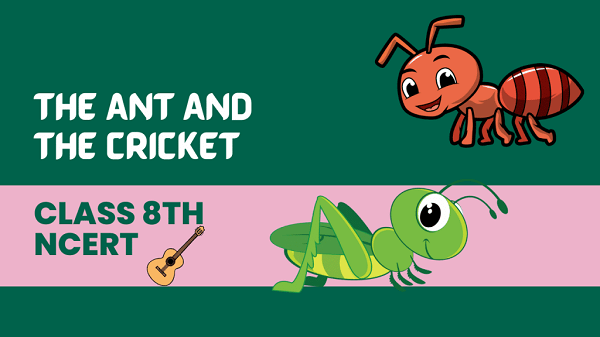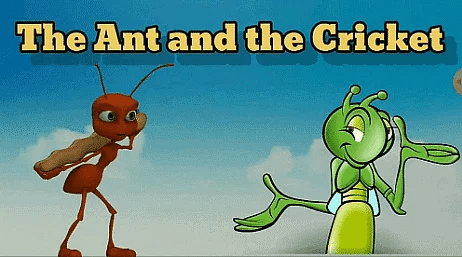The Ant and the Cricket Summary Class 8 EnglishIntroductionThe Ant and the Cricket is a lyrical story. A fable is a story with a lesson to teach that often has creatures as the main characters. This poem has an annoying young cricket and an ant. From Aesop's Fables, the poem "The Ant and the Cricket" was borrowed. However, the poem conveys a valuable lesson about life via a small ant. The lesson may be applied to circumstances involving "two-legged crickets" (people) in addition to the "four-legged" insect. 
Overview of "The Ant and the Cricket"The first line of the poem "The Ant and the Cricket" tells the tale of a young, foolish cricket who was used to singing day and night throughout the summer and spring seasons. He began to worry about his empty pantry right away as winter arrived. He was unable to locate even one crumb of food on the snow-covered land. He had no protection, and he was unable to view flower petals or tree leaves. He worries about what will happen to him if he is not provided with a portion of food and a place to live. He decided to ask the small ants for assistance since he was wet, hungry, and in a food shortage. He just wanted a spoonful of grain and some shelter from the rain. Without it, he must starve to death and endure great suffering. However, the ant had a set of rules. They don't lend or borrow. When there was plenty of food and water, the ant questioned the cricket about what he did throughout the summer and in the spring. He admitted to the ant that he sang nonstop, day and night, with no thought of the future. The ant further counsels him to dance the winter away in a similar manner. He is then thrown out the door by the ant. The poet says that others believe it to be merely a myth, but he disagrees and even provides evidence to support his claim. He is one of many "four-legged" and "two-legged" crickets who recklessly spend their time without making plans for unfavorable situations. About AuthorThe Greek fabulist and storyteller Aesop has been associated with creating many tales that have come to be known as Aesop's tales. Over 600 fables, which are short tales with a moral or lesson to impart, are attributed to Aesop. The protagonists are creatures with human characteristics. The Ant and the Grasshopper and The Hare and the Tortoise are two of his well-known tales. The roughly 600 fables were most likely not all created by Aesop; rather, he most likely repeated many of them that he had heard from storytellers who had come before him. The fables were probably collected by Aesop, who then repeatedly told them. Even though the fables may not have been created by Aesop or even recorded, he is given credit for others' creations because he gathered them and recounted them to kids as stories with lessons. The fables originated as generational tales, potentially dating back to the fourth century BC. Before Aesop heard them and began compiling them, the tales were handed down from one generation to the next. The current form was probably recorded by Babrius in the third century BC. Fables are mythical stories that are based on actual events, human behavior, and the character of the individuals in those situations. Children were substituted for humans in these tales by Aesop in favor of animals, plants, or inanimate things. Similar tales may be found in Hindu and Buddhist literature. Characters Description in the StoryThere are two main characters in the story: the ant and the cricket those are described below: 
1. The AntThe ant works diligently and responsibly. Knowing that it will require adequate nourishment to survive the winter, it focuses its time on collecting food and preparing for the season. The ant does not waste time since it is devoted to its task. 2. The CricketCricket has a weak sense of responsibility. It is just concerned with enjoying the moments it spends in the winter; it spends its time singing and playing and has no understanding of the value of planning for the future. Cricket lives with a carefree and upbeat attitude. It has faith that things will turn out for the best in the end and is unconcerned about the future. Summary of the PoemThere are 4 stanzas in the poem which are explained below: Stanza 1The poet describes a juvenile cricket, an insect like a grasshopper, who was foolish (lacked reason or knowledge) and used to love singing throughout the spring and summer. Because they are filled with energy, the poet refers to the spring and summer seasons as cheerful. There is vegetation all around. Food and water are available in enormous quantities. Regardless, those months of pleasure and celebration quickly came to an end, and winter set in. The cricket had gotten into difficulty. When he arrived home and saw that his pantry was empty, he started to panic. There was absolutely nothing to eat?not even a crumb, which is a little piece of bread. Even though there was snow covering the ground, he was unable to make out one flower or tree leaf. When he notices this, he feels depressed and cries, "Oh, what will become of me?" Word Definition
Stanza 2The insect was hungry since it had not eaten anything. It gathered the bravery to go ask a miserly ant for assistance (to give it a mouthful of grain, or nourishment, and shelter from the storm). Famine, extreme cold, and maybe rain caused the cricket to get wet and shiver a lot while traveling. It asked the ant for food and shelter, promising to pay it back the next day Word Definition
Stanza 3The ant responds to the cricket by saying that it sees itself as both a buddy and his (the cricket's) servant. The ants, on the other hand, never lend or take anything. Saying this, the ant asks the cricket why it didn't collect anything throughout the warm months of spring and summer or when it was the right time. When the ant speaks to the cricket, the cricket responds that it is joyful and carefree since its soul is so light. The cricket goes on to state that it continued to sing day and night since everything in nature seemed to be glad and joyous, or gay. He believed that plenty of food and shelter, as well as the appealing colors of spring and summer, would always be there. The future didn't interest him at all. Word Definition
Stanza 4The ant informs the cricket that he was singing and having a good time throughout the spring and summer and that if he continues to do so, the winter will end. The ant rapidly raised the wicket after saying this, ending the dialogue and shoving the unfortunate cricket out the door. In the final two lines, the poet claims that people refer to the ant and cricket narrative as a fable (i.e., an inaccurate story). He does, however, believe that the tale is largely accurate because there are both crickets with four legs and those with two, i.e., there are pests like crickets who do not give a damn about the future, and there are also humans (crickets with two legs here refer to humans) who do not give a damn about the future and apologize when the time has passed. ConclusionThe moral of the story is that we shouldn't act like crickets. We must constantly plan for the future so that we won't have to rely on others for assistance when things get tough. It also tells us that, unlike the ant, we will likewise be helpful to others. This story also teaches us the importance of working hard. We discover that all work and no play are just as destructive as all play and no work. We shouldn't appreciate the present unless our future is safe. We shouldn't be lazy and needy. |
 For Videos Join Our Youtube Channel: Join Now
For Videos Join Our Youtube Channel: Join Now
Feedback
- Send your Feedback to [email protected]
Help Others, Please Share









